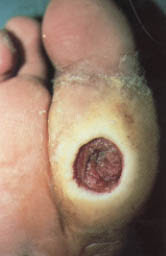Nursing Interventions Fluid Volume Deficit - NCP Diabetic Ulcer
Characterized by: decreased skin turgor and dry mucous membranes.
Goal: fluids or hydration needs are met.
With the expected outcomes:
Patients showed adequate hydration evidenced by stable vital signs, peripheral pulses can be palpated, skin turgor and capillary refill is good, proper urine output of individual and electrolyte levels within normal limits.
Nursing Interventions Fluid Volume Deficit - Nursing Care Plan for Diabetic Ulcer:
Independent:
1. Assess the client's history with respect to the duration or intensity of symptoms such as vomiting and excessive spending urine.
Rational:
Help estimate the total volume deficits. The process of infection resulting in fever and hypermetabolic conditions that increase water loss.
2. Monitor vital signs, note any changes in orthostatic blood pressure.
Rational:
Hypovolemia manifested by hypotension and tachycardia. Estimate the severity of hypovolemia as systolic blood pressure ≥ 10 mmHg fall from a lying position to a sitting or standing.
3. Monitor your breathing pattern as the Kussmaul breathing or breathing that smell ketones.
Rational:
Need to remove the carbonic acid produced by respiratory alkalosis respiratoris compensation to the state of ketoacidosis. Acetone breath odor caused asetoasetat acid solution and should be dropped when ketosis corrected.
4. Monitor the frequency and quality of breathing, use of accessory muscles breathing, periods of apnea and cyanosis.
Rational:
Hyperglycemia and acidosis causes normal breathing pattern and frequency. However, increased work of breathing, and rapid shallow breathing and cyanosis is indicative of respiratory fatigue or loss of capacity through compensation in acidosis. '
5. Monitor temperature, skin color, or moisture.
Rational:
Fever, chills, and diaphoresis are common in the infection process, fever with rash, dry is a sign of dehydration.
6. Assess peripheral pulses, capillary refill, skin turgor, and mucous membranes.
Rational:
An indicator of the level of dehydration or adequate circulating volume.
7. Monitor input and output.
Rational:
Estimating the need for fluid replacement, renal function, and the effectiveness of a given therapy.
8. Measure weight every day.
Rational:
Provides the best assessment of the fluid status of ongoing and further in giving replacement fluids.
9. Maintain a minimum of 2500 ml of fluid / day.
Rational:
Maintaining hydration or circulating volume.
10. Improve the environment that cause a sense of comfort. Cover the client with a thin cloth.
Rational:
Avoid excessive heating of the client can further lead to loss of fluid.
11. Assess mental or sensory changes.
Rational:
Mental changes associated with hyperglycemia or hypoglycemia, electrolyte abnormalities, acidosis, decreased cerebral perfusion, and hypoxia. Cause untreated, the disorder predisposing to aspiration awareness on the client.
12. Observation nausea, abdominal pain, vomiting, and stomach distention.
Rational:
Lack of fluids and electrolytes alter gastrointestinal motility sehinnga often cause vomiting and potentially lead to lack of fluids and electrolytes.
13. Observation of an increased sense of fatigue, edema, weight gain, irregular pulse, and vascular distension.
Rational:
Fluid for rapid improvement potential fluid overload and chronic heart failure.
Collaboration
14. Give fluid therapy as indicated:
Rasiona:
The type and amount of liquids depends on the degree of lack of fluids and individual client response.
15. Normal saline or half normal saline with or without dextrose.
Rational:
Plasma expanders (replacement) is required if a life-threatening blood pressure was not able to return to normal with rehydration efforts that have been made.
16. Insert the catheter urine.
Rationale: Provides precise measurements of the expenditure urine, especially if autonomic neuropathy causing retention or incontinence.

0 komentar: